Arizona school districts’ and charter schools’, and ADE’s discretionary, COVID-19 federal relief spending—in fiscal year 2022 and in total through June 30, 2022
Issued January 1, 2023; initial followup July 20, 2023, final followup November 2, 2023
This special report provides summary information and 4 interactive dashboards with Arizona school districts’ and charter schools’ reported spending in fiscal year 2022 and through June 30, 2022, and planned spending of allocated/awarded COVID-19 federal relief monies, as required by Laws 2021, Ch. 408, §54.
This special report also provides Arizona Department of Education (ADE)-reported spending for fiscal year 2022 and through June 30, 2022, and planned future spending of the discretionary COVID-19 federal relief monies that it received, as required by the law. This information is included below the dashboards and “Report-wide footnotes” sections.
Our January 1, 2023, report included 3 findings and recommendations related to district and charter planned future relief monies spending, noncompliance with statutory reporting requirements, and district- and charter-reported information that appears inconsistent and potentially misreported. In July 2023, we issued a followup to our January 2023 report, describing districts’ and charters’ efforts to implement recommendations from the 3 findings in the "Summary” and “Findings, recommendations, and followup” expandable sections. Specifically, we followed up with districts and charters to obtain additional detail about their planned future relief spending and to provide an opportunity to correct noncompliance with reporting requirements. We also gathered audited fund balance information for all districts and charters to provide more complete and transparent financial information. To provide accurate and complete financial reporting for decision-makers, stakeholders, and the public, we continued to follow up with the districts and charters that were cited for noncompliance and updated their information, as applicable, in November 2023. This final followup concludes our work on the districts’ and charters’ efforts to implement recommendations from our January 2023 report.
Districts and charters reported spending $2.2 billion, or almost half, of their relief monies through June 30, 2022

Districts and charters reported spending just over $2.2 billion, or 48 percent, of their nearly $4.6 billion allocated relief monies through June 30, 2022. See Dashboard A for additional total spending details and Dashboard B for spending by individual district or charter.
ADE had yet to spend/distribute almost $322 million, or 79 percent, of its discretionary relief monies as of June 30, 2022

ADE identified spending priorities for its discretionary relief monies, of which it had $321.7 million, or 79 percent, yet to spend/distribute as of June 30, 2022. See “ADE’s reported spending for FY 2022 and in total through June 30, 2022, and planned future spending” section below for more information on ADE’s spending and planned future spending.
Districts’ and charters’ reported largest portion of spending through June 30, 2022, and planned future spending of relief monies on maintaining operations
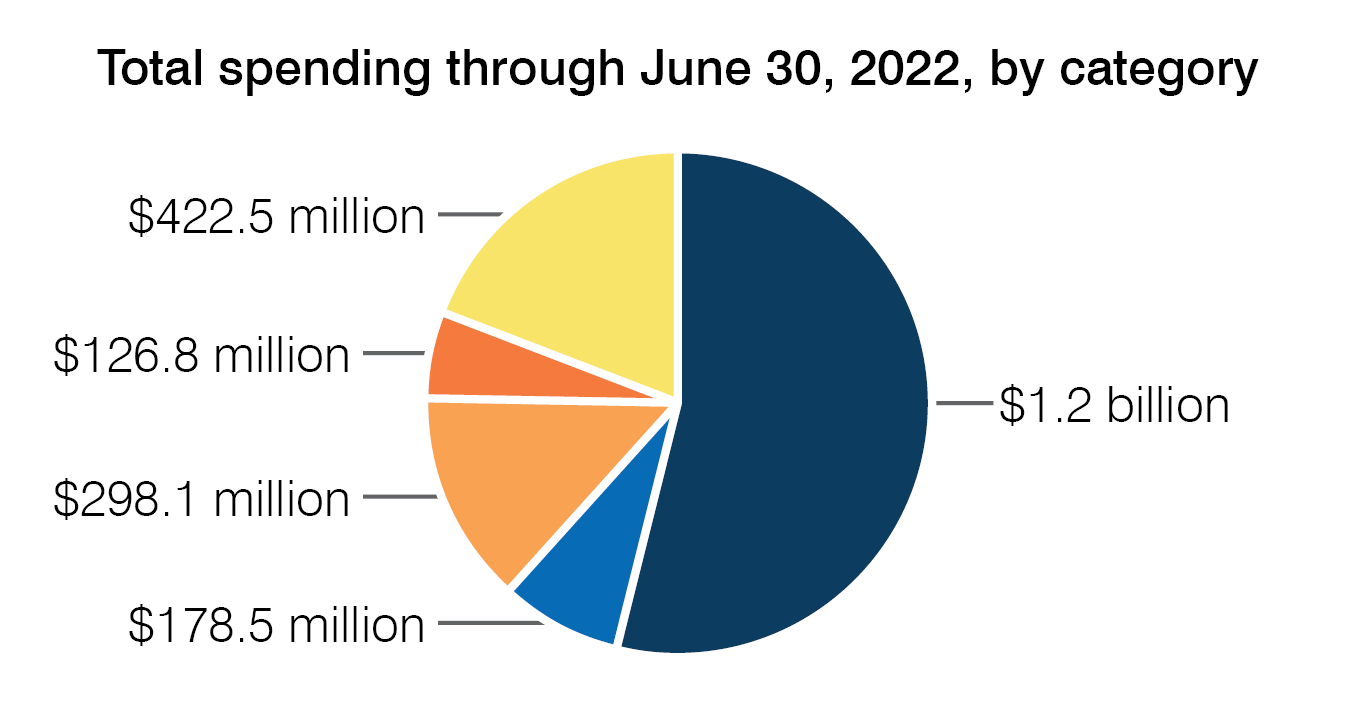
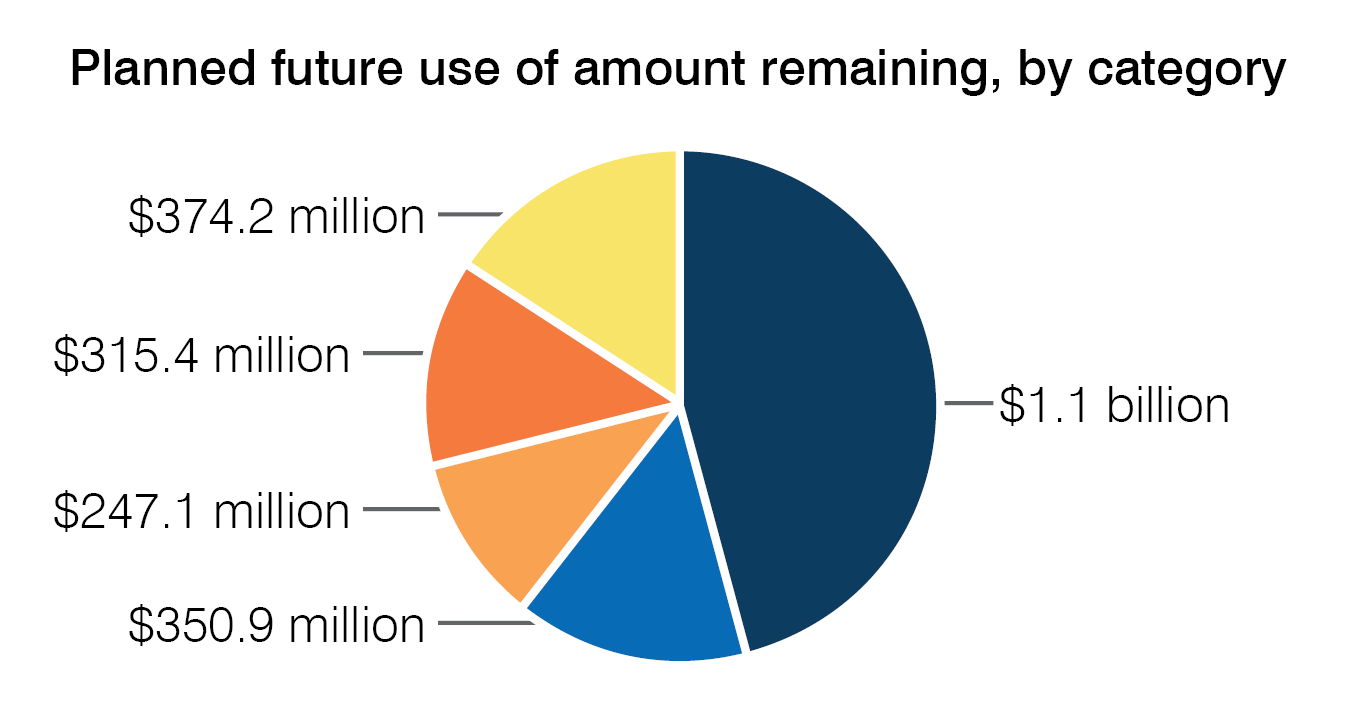
 Maintaining operations Maintaining operations |
 Technology Technology |
 Other spending categories Other spending categories |
 New programs/curriculum New programs/curriculum |
 School facilities repairs School facilities repairs |
Districts and charters continued to report spending and planning to spend the largest portion of relief monies on maintaining operations, almost $1.2 billion, or 54 percent, spent through June 30, 2022, and almost $1.1 billion, or 45 percent, planned for future spending. In FY 2022 alone, districts and charters reported spending $572.5 million on maintaining operations. See Dashboards A and B for total spending details and Dashboard D for FY 2022 spending details, including by individual district and charter.
Districts and charters reported most planned future spending of relief monies for maintaining operations for salaries and benefits; and most planned costs will be eliminated or phased out when these monies are no longer available

Of the almost $1.1 billion of remaining relief monies districts and charters reported planning to spend on maintaining operations, districts and charters reported detailed spending for over $1.0 billion, indicating they plan to spend nearly $512.5 million, or 50 percent, on classroom salaries and benefits; approximately $224.8 million, or 22 percent, on nonclassroom salaries and benefits; and the remaining $293.9 million, or 28 percent, on other classroom and nonclassroom spending to maintain operations.

Further, districts and charters reported over $603.3 million, or 59 percent, of planned spending would be for one-time costs or ongoing costs that would phase out and approximately $186.7 million, or 18 percent, of the planned spending would be for ongoing costs that will continue to be funded with alternative revenue sources when the relief monies are no longer available. Of the 276 districts and charters planning to support future maintaining operations spending from an alternative revenue source, 78 percent plan to use some State equalization assistance to fund at least a portion of their spending. The other most common revenue sources identified were existing fund balances, followed by other federal grants, and State grants. However, districts and charters reported that they did not evaluate $241.1 million, or 23 percent, of their planned spending, and they may need to phase out those costs if an alternative funding source cannot be identified before relief monies are no longer available.
See Dashboards A and B for total planned spending details, including by individual district and charter.
Districts and charters reported most relief monies spent to maintain operations through June 30, 2022, were spent on classroom and nonclassroom salaries and benefits

Of the almost $1.2 billion of relief monies districts and charters reported spending on maintaining operations through June 30, 2022, districts and charters reported spending nearly $855.6 million, or 72 percent, in the classroom, which includes over $754.4 million spent on classroom-related salaries and benefits and over $101.1 million spent on other classroom-related costs. The remaining over $340.5 million, or 28 percent, spent on maintaining operations was spent on nonclassroom salaries, benefits, and other costs.
See Dashboard A for the classroom and nonclassroom spending details for all spending categories, State-wide or by county or legislative district; and see Dashboard B for related details by individual district or charter.
State-wide district and charter ending fund balances have increased every year since FY 2018, including a $1.45 billion increase after FY 2020 when they first received relief monies
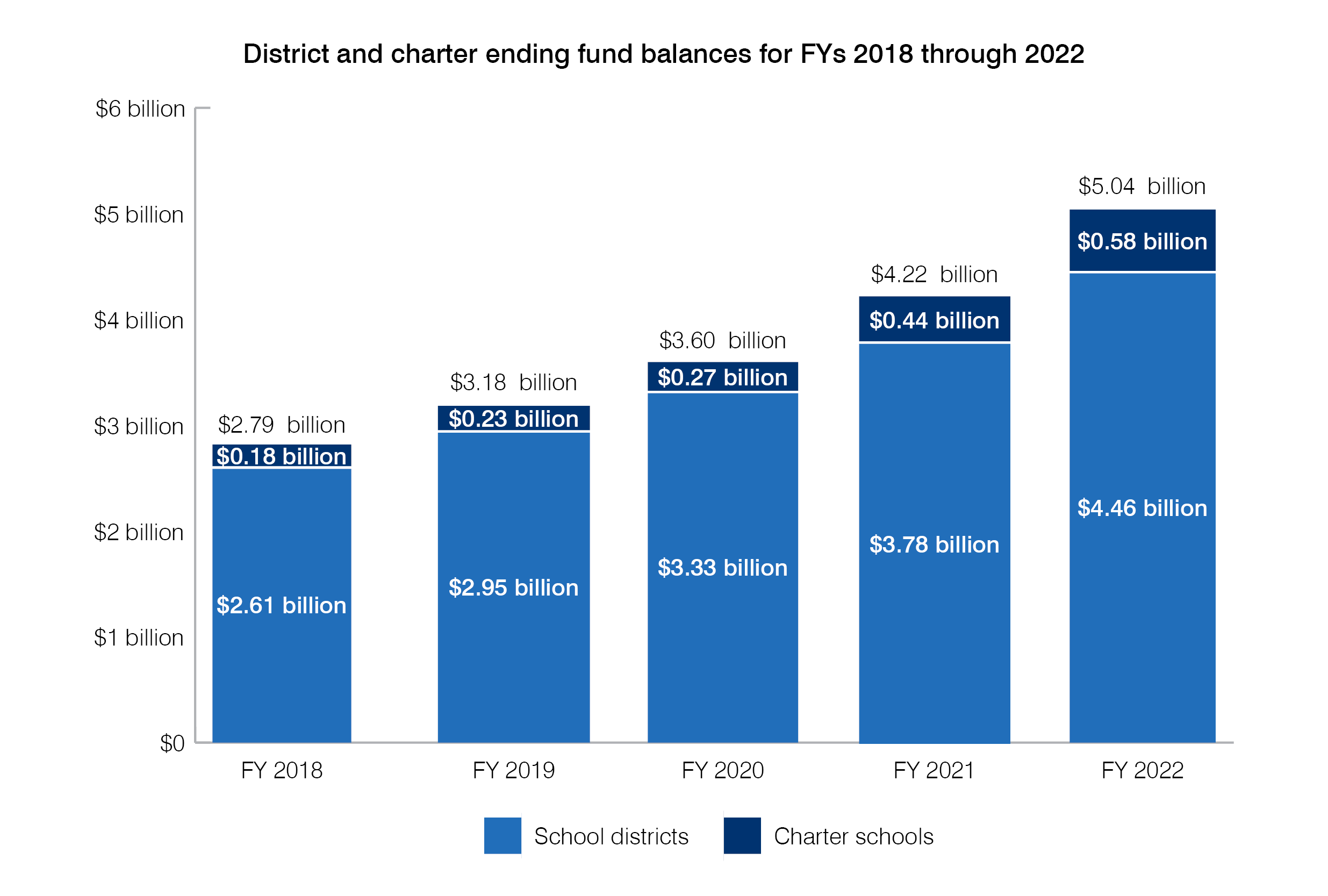
While some districts and charters have experienced decreasing fund balances, most districts and charters increased fund balances between FYs 2018 and 2022. State-wide ending fund balances increased over $1.45 billion, or approximately 40 percent, after FY 2020, the first-year districts and charters received relief monies. Specifically, since FY 2020 district fund balances increased over $1.14 billion, or 34 percent, and charter fund balances increased approximately $0.31 billion, or 115 percent.
Districts and charters reported spending the majority of relief monies through June 30, 2022, in addition to their available State and local monies but fund balance information appears to contradict and raises questions

Through June 30, 2022, districts and charters reported spending almost $1.7 billion, or 76 percent, of the total $2.2 billion relief monies they spent as being in addition to available State and local monies and just under $531.0 million, or 24 percent, as being instead of available State and local monies. However, 217 districts and charters reported relief monies spending that appears to contradict fund balance information, which raises questions about the reliability of the information they reported (see the summary of findings, recommendations, and followup below and the “Finding 3, recommendation, and followup” section for more details).
Districts and charters reported spending relief monies through June 30, 2022, in addition to available State and local monies primarily for new costs

Of the $1.7 billion districts and charters reported spending in addition to available State and local monies, almost $1.3 billion, or 76 percent, was reported as spent on new costs that were not similar to costs districts and charters incurred prior to March 2020, the start of the COVID-19 pandemic. See below for the types of new costs districts and charters reported incurring.
Districts and charters reported incurring new costs after the start of the pandemic in March 2020, such as salaries and benefits costs including extra duty pay for existing staff and technology

|
Districts and charters reported spending $517.5 million on new salaries and benefits costs with just over $138.0 million, or 27 percent, spent for adding positions for other than student population growth and $166.1 million, or 32 percent, spent for extra duty pay to existing staff. |
|
Districts and charters also reported spending almost $869.6 million on all other new costs with $206.6 million, or 24 percent, spent for technology. Costs reported as “other” can include purchased professional and technical services; employee training and professional development services; safety items such as PPE; purchased property services such as utilities and trash disposal; community services; tuition; and debt service payments for principal and interest. See Dashboard C for additional reported spending details, including how districts and charters reported spending relief monies in addition to or instead of available State and local monies within each spending purpose shown. |
Findings, recommendations, and followup
Our January 2023 report contained 3 findings and recommendations related to district and charter planned future relief monies spending, noncompliance with reporting requirements, and district- and charter-reported information that appears inconsistent. The follow-up implementation status of those recommendations is as follows:
Finding 1: Districts and charters plan to spend $1.1 billion of remaining COVID-19 federal relief monies that expire in 2024 for ongoing expenses to maintain operations; therefore, they need to develop plans for operational needs supported by these monies
November 2023 follow-up implementation status: Approximately 40 percent of districts and charters reported having a written plan for supporting operations once their federal relief monies planned for maintaining operations are no longer available; however, some districts and charters without a written plan were able to classify most reported planned maintaining operations spending into 3 categories: one-time costs, ongoing costs that will be phased out, and ongoing costs that will be supported from alternative funding sources.
Specifically, of the 593 districts and charters that reported maintaining operations planned spending, only 240 reported they had a written plan for meeting operational needs when these relief monies are no longer available after September 2024, while 350 reported they did not have a written plan. Additionally, 3 charters failed to respond to our repeated requests for plan information. See the “Finding 1, recommendation, and followup” section below and Dashboards A and B for additional details about the maintaining operations planned spending classifications.
Finding 2: Some districts and charters failed to report statutorily required financial information necessary for relief spending special report, limiting transparency and completeness of information for decision-makers, stakeholders, and public
November 2023 follow-up implementation status: Most districts and charters we previously cited for noncompliance with statutorily required reporting resubmitted reporting forms that corrected their noncompliance; however, some districts and charters did not correct their noncompliance, and some districts and charters did not submit required follow-up reporting.
Specifically, of the 21 districts and 64 charters that originally did not comply with the statutory reporting requirements:
- 12 districts and 48 charters resubmitted COVID-19 reporting forms that corrected their cited noncompliance item(s) by July 2023.
- 9 districts and 11 charters resubmitted COVID-19 reporting forms that corrected their noncompliance item(s) by November 2023.
- 5 charters did not correct their cited noncompliance item(s) and are referenced with the applicable footnote(s) in the dashboards.
Further, 3 charters did not submit required follow-up reporting. See the “Report-wide footnotes” section below for information on the specific reporting noncompliance; the data file for filtering instructions for how to generate a list of the noncompliant districts and charters by the specific nature of the noncompliance; and the “Finding 2, recommendation, and followup” section below for additional information.
Finding 3: Some districts and charters reported financial information that appears inconsistent when compared to other financial information, indicating they may have misreported information and limiting the availability of complete and transparent information on relief money spending impacts
November 2023 follow-up implementation status: Dashboard C includes fund balance information from audited financial statements or annual financial reports when financial statements were not available and shows that 217 districts and charters reported relief money spending in addition to or instead of State and local monies that appears to contradict their reported fund balance increase or decrease.
Therefore, to increase transparency and provide decision-makers, other stakeholders, and the public more complete financial information, the Auditor General added additional fund balance/reserve reporting to district and charter FY 2023 annual financial reports and will add similar required reporting to FY 2025 budget forms. See the “Finding 3, recommendation, and followup” section below and Dashboard C for additional details about reported relief spending and fund balances.
To access information, first choose which of the 4 dashboards you want to use (A, B, C, or D as described below) by selecting the applicable button along the top. Below those buttons, you can select different options to filter the data, such as by legislative district, county, or district or charter, as desired. Groups of districts and charters can be selected by legislative district or county on Dashboard A. Only one district or charter may be selected at a time on Dashboards B, C, and D. To enlarge a table or chart, choose the focus mode option at the item’s top right corner. For amounts that appear blank within Dashboards B, C, and D, the district or charter did not report the information as described in the applicable footnote(s) described in the “Report-wide footnotes” section below.
District and charter spending descriptions
Spending by category
|
Category |
Examples of relief grant spending classified by category: |
|
| Maintaining operations and continuity of educational services | Payments to continue employing existing classroom and nonclassroom staff and payments for other planned operating costs. | |
| New programs/curriculum to address learning loss and unique student needs | Academic progress assessments, instructional delivery modifications, summer enrichment, after-school programs, etc. | |
| Mental and medical health services and support for students and/or staff | Counseling, COVID-19 testing, and vaccinations. | |
| Personal protective equipment (PPE) and cleaning and sanitizing | Face masks; plexiglass barriers and shields; cleaning and sanitizing supplies and equipment; contracted cleaning services; and additional cleaning personnel costs. | |
| Technology-related spending | Hardware, software, and connectivity equipment and fees. | |
| School facility repairs, improvements and additions | Allowable inspection, testing, maintenance, and upgrade projects to existing facilities or renting new space. | |
| Food service programs | Staff, equipment, supplies, and transportation costs to deliver meals to students. | |
| Miscellaneous | Staff training and other allowable grant purposes. | |
Spending by operational area and type
Districts and charters report financial transactions in accordance with a uniform chart of accounts. The Uniform System of Financial Records for Arizona School Districts and Uniform System of Financial Records for Arizona Charter School s provide more detailed descriptions of the operational areas (function codes) and type (object codes) listed below:
Operational area includes the costs incurred in the day-to-day operations in these categories:
- Classroom spending—includes instruction costs of activities that deal directly with the interaction between teachers and students, student support costs for activities that assess and improve the students’ well-being, and instruction support costs of activities that assist instructional staff with the content and process of providing learning experiences for students.
- Administration—includes costs for activities associated with establishing and administering policy and operating the school, including Superintendents, principals, business managers, and clerical staff.
- Plant operations—includes costs to repair and maintain facilities and equipment, such as heating, cooling, lighting, and property insurance.
- Transportation—includes costs related to maintaining buses and transporting students to and from school and school activities.
- Other areas—includes food service, principal and interest payments on debt, other programs outside the scope of preschool through grade 12 education, and indirect costs.
Spending by type describes the goods and services purchased:
- Salaries and benefits—includes payments made to or for the benefit of district and charter staff.
- Purchased services—includes payments to individuals or firms that provide specialized skills or knowledge, including nonemployee teachers and other personnel.
- Supplies—includes payments for items that are consumed or deteriorated through use in teaching, operating the district, or constructing or repairing facilities.
- Property—includes payments to acquire land, buildings, and equipment.
- Other—includes all other payments not included in other categories, including principal and interest on debt financed equipment.
Classroom and nonclassroom spending:
- Classroom spending—includes instruction costs of activities that deal directly with the interaction between teachers and students, student support costs for activities that assess and improve the students' well-being, and instruction support costs of activities that assist instructional staff with the content and process of providing learning experiences for students.
- Nonclassroom spending—includes administration, plant operations, food service, and transportation costs.
Footnotes indicated in parentheses on specific district and charter names in Dashboards B, C, and D are described below. Bold numbers below identify footnotes related to districts and charters that did not comply with the described reporting requirements. See the "Finding 2, recommendation, and followup” section for summary information on district and charter reporting requirement noncompliance.
(1) Not used. Districts and charters are no longer identified as noncompliant for failure to submit FY 2022 COVID-19 reporting form. All previously noncompliant districts and charters submitted the required forms during our follow-up process. See the "Finding 2, recommendation, and followup” section.
(2) The district or charter failed to comply with statutory COVID-19 federal relief spending reporting requirements and include or classify accounting data correctly to ensure complete, accurate, and transparent reporting. See the "Finding 2, recommendation, and followup” section.
(3) Not used. Districts and charters are no longer identified as noncompliant for failure to report ending fund balance information. We collected ending fund balance information for all districts and charters from audited financial statements or unaudited annual financial reports, when audited financial statements were not available. See the "Finding 2, recommendation, and followup” section.
(4) The district or charter reported total spending in detail that did not agree to its reported total award spending from all COVID-19 federal relief grants as shown on Dashboard B, “Total COVID-19 federal relief awards, spending, and amount remaining through June 30, 2022” table. For example, the total spending in that table did not agree to Dashboard B, “Total COVID-19 federal relief classroom and nonclassroom spending through June 30, 2022, by category” table and/or the Dashboard C, “COVID-19 federal relief spending detail for continuing and new costs in addition to or instead of available State and local monies through June 30, 2022” table.
(5) Based on our analysis of grant awards, the district or charter did not report award amount or spending for other grant allocations awarded by grantor agencies that we were able to confirm with grantors. Therefore, we increased the “Other award” amounts and as no spending was reported we adjusted planned future spending in “maintaining operations” to balance the award with spending and planned spending amounts. We adjusted category spending in “maintaining operations” or other allowable spending categories based on the grant requirements, as applicable, to align reported category spending to total reported award spending. For food service awards, we increased the food service category for nonclassroom other spending for the amount ADE provided.
(6) The district or charter did not consistently report detailed spending as “salaries and benefits” or “other” throughout the report. Therefore, spending by these types does not always agree between tables on Dashboards B, C, and D.
(7) The district or charter did not consistently report spending amounts in total throughout the report. Therefore, total spending does not agree between tables on Dashboards B and C.
(8) Not used. Districts and charters are no longer identified as reporting unreliable fund balance changes as we reported FYs 2018 through 2022 fund balance information for districts and charters from audited financial statements or unaudited annual financial reports (AFR) when audited financial statements were not available. See the “Sources, Scope, and Methodology” section below for more information.
(9) The district or charter closed; therefore, it did not submit a FY 2022 COVID-19 reporting form. We reported all award and spending information that was previously reported in our COVID-19 spending through June 30, 2021, report.
(10) Not used. Districts and charters are no longer identified as noncompliant for failure to complete the classroom and nonclassroom spending detail information in their FY 2022 COVID-19 reporting form. All previously noncompliant districts and charters submitted the required information during our follow-up process. See the "Finding 2, recommendation, and followup” section.
(11) Not used. Districts and charters are no longer identified as noncompliant for failing to complete statutorily required reporting of continuing and new cost spending detail in addition to or instead of available State and local monies in their FY 2022 COVID-19 reporting form. All previously noncompliant districts and charters submitted the required information during our follow-up process. See the "Finding 2, recommendation, and followup” section.
(12) The district or charter reported all or most of their FY 2022 COVID-19 federal relief spending was in addition to available State or local monies, but their reported fund balance increased, which appears to indicate some of their spending was instead of available State and local monies.
(13) The district or charter reported all their FY 2022 COVID-19 federal relief spending was instead of available State and local monies, but their reported fund balance decreased, which appears to indicate some of their spending was in addition to State and local monies.
(14) Not used. Districts are no longer identified as noncompliant for failure to submit their required FY 2022 financial statement audit. All districts submitted their required audits during our follow-up process.
(15) The district or charter did not comply with statutory COVID-19 federal relief spending reporting requirements as it did not report additional details for planned future relief monies spending in the maintaining operations category reported on Dashboard B. See the "Finding 2, recommendation, and followup” section.
(16) The district or charter did not consistently report planned maintaining operations spending amounts. Therefore, total planned maintaining operations spending does not agree between tables on Dashboard B.
Between March 2020 and June 30, 2022, ADE received a total of $405.9 million in relief monies, of which $225.0 million was categorized as administrative and discretionary monies and $180.9 million was required set-aside monies for State-wide strategic projects and investments that support schools’ recovery needs and increase learning opportunities for students.
ADE reported spending $84.2 million, or 21 percent, of its discretionary relief monies through June 30, 2022. Most of this spending, $37.7 million, or 45 percent, was provided to districts and charters for additional relief funding as allowed by the federal government. ADE reported that it plans to spend $73.7 million, or 23 percent of the $321.7 million total remaining amount, for the same purpose in future years. ADE’s reported spending through June 30, 2022, and planned future spending, by category, and goals and descriptions are provided below. ADE’s website contains additional spending details about ESSER and American Rescue Plan set aside spending.
ADE’s reported spending through June 30, 2022, and planned future spending, by category, and goals and descriptions
Additional relief funding to public schools — Goal: Baseline levels of relief funding for all public schools.
Provide additional funds to ensure a baseline level of relief funding for public-school districts, nonprofit charters, and career and technical education districts.
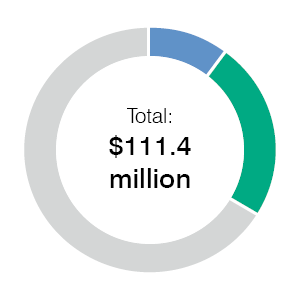 |
|
Student equity and achievement— Goal: Increase proficiency for all students and close achievement gaps.
Engaging and empowering Arizona students to reach their full potential and providing opportunities for equitable academic outcomes so all students have access to multiple pathways to achieve life-long success
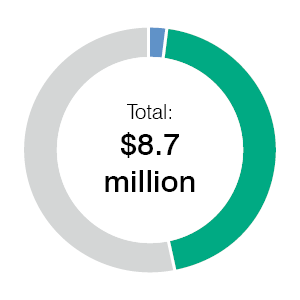 |
|
Educator recruitment and retention— Goal: Every student has access to qualified educators and leaders.
Inadequate retention and recruitment of teachers and other professionals providing specialized student support, such as school counselors, has led to a staffing shortage in schools. Highly effective teachers in the classroom are the biggest predictor of student success. Arizona must foster a robust, State-wide teaching profession where educators can grow and thrive professionally and personally.
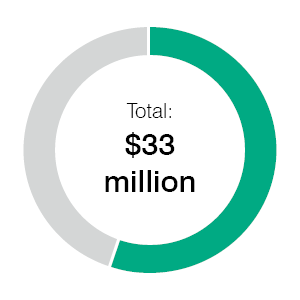 |
|
Safe and healthy schools— Goal: All students will learn and grow in a safe and healthy environment.
Integral to every child’s education is their social-emotional wellbeing, of which mental and physical health and safety have a primary role. Schools need resources and information to sustain safe, healthy, supportive, and inclusive environments for students, families, and educators.
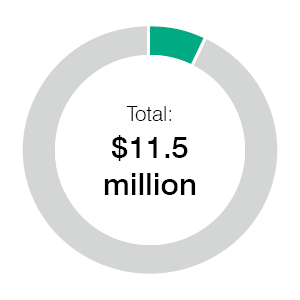 |
|
Serving the Arizona school community through the pandemic— Goal: Help schools and families address disruptions resulting from the emergency of the pandemic.
Schools also need support to help prepare for safe school openings, as well as future disruptions to health and access to learning.
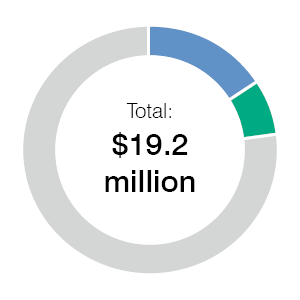 |
|
Bridging the digital divide and providing access to digital resources— Goal: Bridge the digital divide and provide access to broadband.
Provide relief to meet immediate needs and address on - going needs and solutions that strengthen connectivity across Arizona and its school communities.
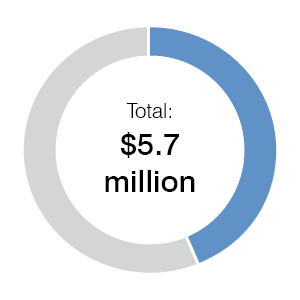 |
|
Postsecondary access and attainment— Goal: All students are prepared to access, and succeed in, post-secondary learning opportunities.
Post-secondary access and success is vital to ensuring all students reach their full potential.
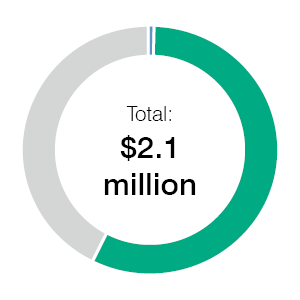 |
|
Administration
Supporting ADE’s grant oversight operations.
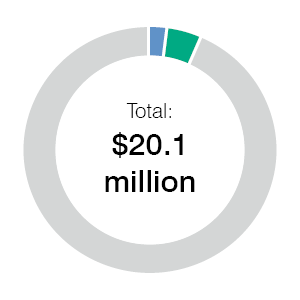 |
|
Other and indirect costs — Goal: Other & Indirect Costs includes funds allocated for indirect cost recovery and State projects that are in process for finalization and/or public announcement.
Indirect costs represent the expenses of doing business that are not readily identified with a particular grant, contract, project function , or activity but are necessary for the general operation of the organization and the conduct of activities it performs. ADE recovers indirect costs on funds allocated for ESSER State Projects per ADE's U.S. Department of Education (USED) approved Indirect Cost rate agreement.
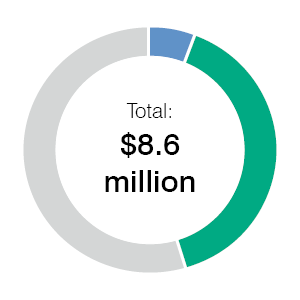 |
|
ESSER III required set-aside monies
Set-aside funds will be allocated in FY 2022 toward State-wide strategic projects and investments that will support schools' recovery needs and increase learning opportunities for students through 2024, primarily per a Request for Grant Proposal Application (RFGA) process based on the recommendations of the Equitable & Effective Schools Taskforce and ADE's ESSER III State Plan, approved by USED on 10/07/2021.
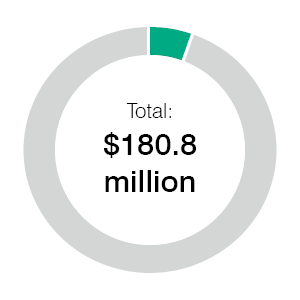 |
|
Other discretionary and administration
ADE’s set-aside funds for administration and other allowable grant activities from grants funded through various COVID-19 federal acts.
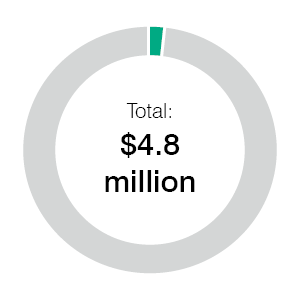 |
|
Districts and charters plan to spend $1.1 billion of remaining COVID-19 federal relief monies that expire in 2024 for ongoing expenses to maintain operations; therefore, they need to develop plans for operational needs supported by these monies
Condition — Less than 2 years remain until the $1.1 billion of remaining one-time COVID-19 federal relief monies (relief monies) that districts and charters State-wide plan to spend for ongoing expenses to maintain operations will expire. Specifically, State-wide, districts and charters reported that they plan to spend $1.1 billion, or nearly half, of their remaining relief monies awarded to them as of June 30, 2022, and expiring September 30, 2024, for maintaining operations. This category—maintaining operations—includes payments to continue employing existing classroom and nonclassroom staff and payments for other planned operating costs rather than for other costs of staff, programs, services, or equipment in response to the COVID-19 pandemic.
This is a substantial amount of remaining relief monies that districts and charters State-wide reported they plan to spend for maintaining operations and for some districts or charters comprises a significant amount of their annual operating monies. State-wide, the total $1.1 billion of remaining relief monies that districts and charters plan to spend for maintaining operations is just over 14.5 percent of FY 2022 State-wide formula funding, and 94 districts and 143 charters reported at least that percentage of planned spending of relief monies for maintaining operations as compared to their FY 2022 formula funding. For example, among those 94 districts, Phoenix Union High School District reported planning to spend over $102.6 million of its remaining relief monies to maintain operations, or nearly 53 percent of its FY 2022 formula funding. Further, Heber-Overgaard Unified School District reported planning to spend nearly $22.8 million of its remaining relief monies to maintain operations, or more than 576 percent of its FY 2022 formula funding. Among those 143 charter schools, ASU Preparatory Academy Digital reported planning to spend nearly $11.7 million of its remaining relief monies to maintain operations, or more than 41 percent of its FY 2022 formula funding. Further, Edkey, Inc.–Sequoia Ranch School reported planning to spend nearly $2.3 million of its remaining relief monies to maintain operations, or more than 263 percent of its FY 2022 formula funding.
Effect — Districts and charters that plan to spend a large portion of their remaining relief monies to maintain operations could face critical operational spending decisions when their one-time relief monies are no longer available as of September 30, 2024. For example, districts and charters reported spending $925 million in relief monies for salaries and benefits, almost 79 percent of their total spent for maintaining operations through June 30, 2022. If they use their remaining relief monies for maintaining operations similarly—largely on salaries and benefits—these districts and charters could have to reduce the number of classroom and nonclassroom staff positions based on reduced available funding to support those positions when the one-time relief monies expire.
Cause — As allowed by federal laws, districts and charters State-wide plan to spend a significant amount of their remaining relief monies to maintain operations rather than for other allowable costs due to the COVID-19 pandemic. The largest source of these monies is the ESSER III grant, which allows the monies to be spent no later than September 30, 2024.
Criteria — Pursuant to federal laws, the relief monies awarded to Arizona districts and charters have various dates by which the monies must be spent, but generally the latest date by which monies can be spent is September 30, 2024. Districts and charters are allowed to spend the monies on continuing (or costs similar to those incurred before the pandemic) and new costs of COVID-19 relief, prevention, and recovery, including maintaining operations and continuity of educational services; new programs/curriculum to address learning loss and unique student needs; mental and medical health services and support for students and/or staff; personal protective equipment (PPE) and cleaning and sanitizing; technology-related spending; school facility repairs, improvements, and additions; food service programs; and staff training.
Recommendation
1. Districts and charters that have planned to spend a large portion of their remaining relief monies for maintaining operations should accurately monitor, track, and record their relief spending and develop a plan detailing the actions they will take in anticipation of the September 30, 2024, deadline for using these one-time monies and the impacts on their continuing operations, such as identifying the sources of revenues to replace these monies or phasing out these expenditures to ensure they can operate within their available resources.
November 2023 follow-up implementation status: Approximately 40 percent of districts and charters reported having a written plan for supporting operations once their federal relief monies planned for maintaining operations are no longer available; however, some districts and charters without a written plan were able to classify most reported planned maintaining operations spending into 3 categories: one-time costs, ongoing costs that will be phased out, and ongoing costs that will be supported from alternative funding sources
Development of a written plan and evaluation of planned spending — As shown in the pie chart below, of the 593 districts and charters that reported maintaining operations planned spending:
-
94 districts and 146 charters (240 total) reported having a written plan for supporting operations once their federal relief monies planned for maintaining operations are no longer available after September 2024. Of those:
-
Only 58 districts and 91 charters (149 total) fully evaluated their planned spending and identified all planned maintaining operations spending as either one-time costs, ongoing costs they plan to phase out, or ongoing costs with an identified alternative funding the source.
-
The remaining 36 districts and 55 charters (91 total) did not fully evaluate their planned spending and reported that they plan to use federal relief monies for some costs that may need to be phased out if an alternative funding source cannot be identified before relief monies expire.
-
-
123 districts and 227 charters (350 total) reported not having a written plan for supporting operations once their federal relief monies planned for maintaining operations are no longer available. Of those:
-
55 districts and 81 charters (136 total) had evaluated their planned spending enough to report amounts of one-time and ongoing costs that will be eliminated and ongoing costs that will be supported from alternative funding sources, indicating they have at least an informal plan for supporting operations after September 2024.
-
68 districts and 146 charters (214 total) reported they had not fully evaluated their planned spending, and some or all planned maintaining operations spending may need to be phased out if an alternative funding source cannot be identified before relief monies expire.
-
-
3 charters failed to respond to our repeated requests for plan information and are identified as noncompliant with that reporting requirement in the Finding 2 followup below.
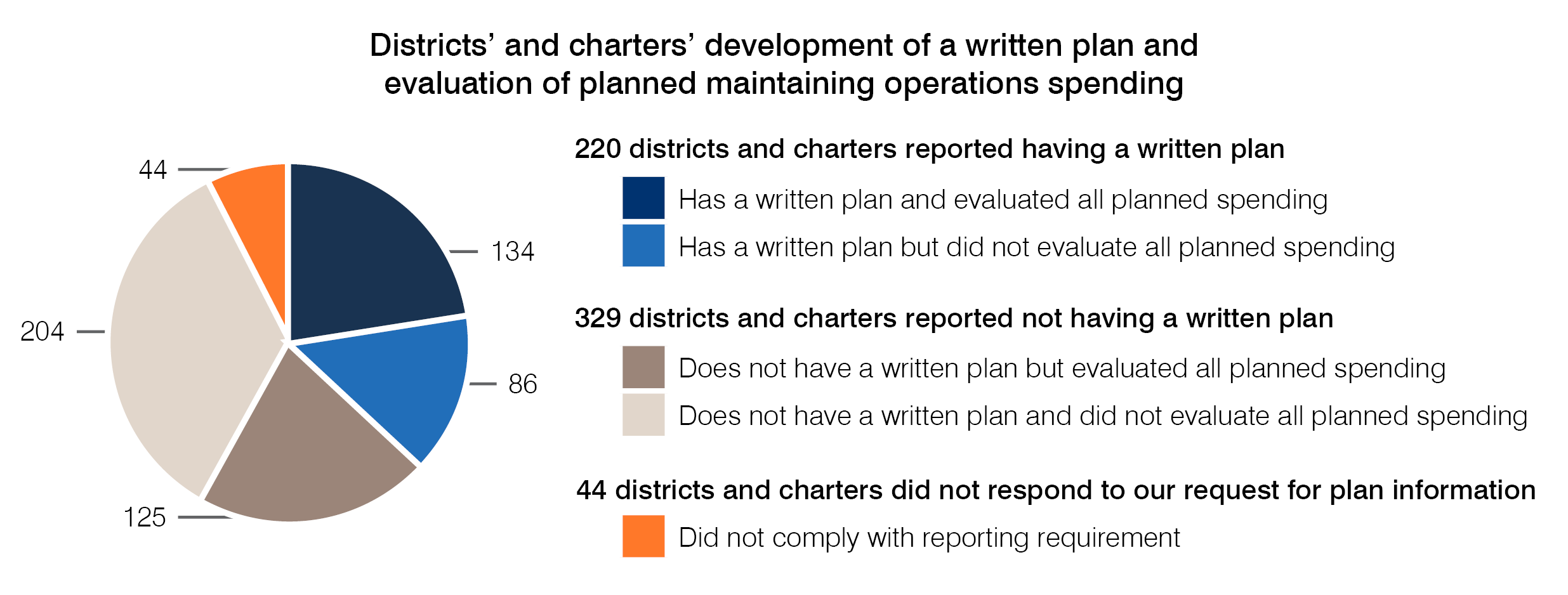
Districts and charters that have not developed plans for supporting operations or evaluated all ongoing costs may have to make difficult and ill-timed decisions such as eliminating classroom or nonclassroom staff positions to continue operating within available revenues when these one-time relief monies are no longer available. Alternatively, districts and charters that plan ahead to support costs from other identified sources or communicate the need to phase out other costs before relief monies are no longer available can reduce the negative impact on their future operations.
Future maintaining operations spending plan details — As shown in the pie chart below, districts and charters classified most reported planned maintaining operations spending as one-time, ongoing costs that will be phased out, and ongoing costs that will be supported from alternative funding sources. Specifically, districts and charters reported $603.3 million, or 57 percent, of planned spending would be for one-time costs or ongoing costs that would phase out and approximately $186.7 million, or 18 percent, of the planned spending would be for ongoing costs that will continue to be funded with alternative revenue sources when the relief monies are no longer available. Of the 276 districts and charters planning to support future maintaining operations spending from an alternative revenue source, 78 percent plan to use some State equalization assistance to fund at least a portion of their spending. The other most common revenue sources identified were existing fund balances, followed by other federal grants, and State grants. However, districts and charters reported that they did not evaluate over $241.1 million, or 23 percent, of their planned spending, and they may need to phase out those costs if an alternative funding source cannot be identified before relief monies are no longer available.

See additional information about the reported planned maintaining operations spending State-wide and by district and charter in Dashboards A and B, respectively.
Some districts and charters failed to report statutorily required financial information necessary for relief spending special report, limiting transparency and completeness of information for decision-makers, stakeholders, and public
Condition — Some districts and charters failed to report statutorily required financial information to ADE in their FY 2022 COVID-19 reporting form, which is the same data used for the relief spending special report. The types of financial information districts and charters failed to report and the numbers of districts and charters with each of these reporting noncompliance issues are described in the table below and can also be viewed by filtering for the applicable footnote in our report’s data file. The footnotes are also identified in Dashboards B, C, and D.
|
Some districts and charters failed to report statutorily required financial information |
||||
|
Financial information that districts/charters failed to report |
January 2023 Report |
November 2023 Follow-up Report |
||
| Number of districts | Number of charters | Number of districts | Number of charters | |
|
Failed to complete and submit their FY 2022 COVID-19 reporting form by the October 15, 2022, due date and still had not completed and submitted this required form by December 5, 2022, the final date we pulled data from ADE for this special report. Therefore, their FY 2022 spending is not included in this report. (1) |
5 |
2 |
No longer applicable | |
|
Failed to include their accounting data or did not identify COVID-19 federal relief grants within the accounting data in their FY 2022 COVID-19 reporting form. The accounting data was required in the COVID-19 reporting form to allow the form’s formulas to directly pull reported spending by operational area and type from that data to increase reporting transparency. (2) |
9 |
59 |
0 | 5 |
|
Failed to report fund balance information in their FY 2022 COVID-19 reporting form. (3) |
6 |
17 |
No longer applicable | |
|
Failed to report COVID-19 spending by category details for classroom and nonclassroom spending in their FY 2022 COVID-19 reporting form. Without this information, we could not report complete details for all COVID-19 spending categories. (10) |
8 |
9 |
No longer applicable | |
|
Failed to report COVID-19 spending detail for continuing or new costs in addition to or instead of available State and local monies in their FY 2022 COVID-19 reporting form. (11) |
3 |
1 |
No longer applicable | |
Source: Auditor General staff analysis of district- and charter-submitted FY 2022 COVID-19 reporting forms and ADE-provided school report card information.
Effect — Due to some districts and charters not reporting statutorily required information, this report does not include some financial information for nonreporting districts and charters, and some of our analyses do not include all districts and charters. Therefore, decision-makers, other stakeholders, and the public do not have complete and transparent information about FY 2022 relief spending or the relief spending through June 30, 2022, and decision-makers may not have complete or accurate financial information upon which to make decisions. For example:
-
Due to 5 districts and 2 charters not submitting their FY 2022 COVID-19 reporting form, we were not able to include FY 2022 relief spending for those districts and charters in this report. These districts’ and charters’ missing information makes the total reported FY 2022 relief spending by Arizona districts and charters and total reported relief spending by Arizona districts and charters from FY 2020 through FY 2022 lower than the actual amounts due to incomplete information.
-
Due to 9 districts and 59 charters not submitting their accounting data with their FY 2022 COVID-19 reporting form, we could not analyze any errors or discrepancies in reported amounts in their reporting form, if noted.
Cause— Districts and charters that failed to provide required financial information did not follow the instructions within the FY 2022 COVID-19 reporting form. The instructions detailed the information that was required to be reported, and the form also provided fields for requested data. In addition, we provided multiple ways for them to contact us if they had any questions about the required information, or ADE if they had questions about submitting the form. Finally, for those districts and charters that did not submit the required information by the initial due date, we provided a reminder email and more than a 1-month extension to submit the information.
Criteria — As required by Laws 2021, Ch. 408, §54, the Auditor General prescribed a FY 2022 COVID-19 reporting form to facilitate districts’ and charters’ compilation and reporting of spending and planned spending of relief monies. That law required districts and charters to cooperate with and provide information and records to the Auditor General in a format prescribed by the Auditor General to facilitate the required reporting. Like other required annual financial reporting forms that the Auditor General prescribes in conjunction with ADE, the FY 2022 COVID-19 reporting form required districts and charters to include their accounting data in the form and specifically identify COVID-19 federal relief grants to allow the form’s formulas to directly pull reported spending by operational area and type from that data to increase reporting transparency.
Recommendation
2. Districts and charters need to comply with all statutory financial reporting requirements and ensure that all required information is reported in the format and manner prescribed by the required deadline to ensure transparent reporting and the availability of complete and accurate financial information for decision-makers, other key stakeholders, and the public.
November 2023 follow-up implementation status: Most districts and charters we previously cited for reporting noncompliance in our January 2023 report resubmitted reporting forms that corrected their noncompliance; however, 5 charters did not correct their noncompliance, and 3 charters did not submit required follow-up reporting.
In the table above, we updated the number of districts and charters that did not comply with each reporting requirement included in our January 2023 report to reflect those that corrected their noncompliance by our final November 2023 followup. Specifically, of the 21 districts and 64 charters that originally did not comply with the reporting requirements:
-
12 districts and 48 charters resubmitted COVID-19 reporting forms that corrected their cited noncompliance item(s) by July 2023.
-
9 districts and 11 charters resubmitted COVID-19 reporting forms that corrected their cited noncompliance item(s) by November 2023.
-
5 charters did not correct their cited noncompliance item(s) and are referenced with the applicable footnote(s) in the dashboards.
Additionally, 3 charters continued to fail to comply with statutory reporting requirements by our November 2023 followup on finding 1 as follows:
|
Some districts and charters failed to report statutorily required financial information |
||
|
Financial information that districts/charters failed to report |
Number of districts |
Number of charters |
|
Failed to report additional details for planned relief monies spending in the maintaining operations category by the April 17, 2023, due date and still had not submitted the information by May 21, 2023, our deadline for obtaining the additional spending detail information for this follow-up report. (15) |
0 |
3 |
See the November 2023 data file for filtering instructions to generate a list of the noncompliant charters by the specific nature of the noncompliance and additional information about the follow-up reporting in the “Finding 1, recommendation, and followup” sections.
Some districts and charters reported financial information that appears inconsistent when compared to other financial information, indicating they may have misreported information and limiting the availability of complete and transparent information on relief money spending impacts
Condition — Some districts and charters reported financial information on their FY 2022 COVID-19 reporting form that appears inconsistent when compared to other financial information they also reported. Specifically:
-
For 26 districts and 63 charters, their reported fund balance information on their FY 2022 COVID-19 reporting form appears inconsistent compared to other district-/charter-reported information.1 We compared all district-/charter-reported changes in fund balances from FY 2020 to FY 2022 to FYs 2021 and 2022 district-/charter-reported revenues and expenditures to identify inconsistent changes in fund balance. For example, we noted districts or charters that reported a fund balance decrease from FY 2020 to FY 2022 although they reported revenues that exceeded expenditures in FYs 2021 and 2022.
-
Some districts’ and charters’ reported spending of relief monies in addition to or instead of available State and local monies did not appear consistent with their reported fund balance increase or decrease on their COVID-19 reporting form. On one extreme, 77 districts and 75 charters reported they spent all their relief monies in addition to available State and local monies.2 However, they reported a fund balance increase, which appears to indicate they spent at least some relief monies instead of available State and local monies. For example:
-
Gilbert Unified School District reported it had spent all $41.5 million of relief monies expended through June 30, 2022, in addition to available State and local monies even though it reported using $30.4 million for continuing costs, like those incurred before the start of the COVID-19 pandemic, including $24.7 million for salaries and benefits costs. The District also reported a fund balance increase.
-
Portable Practical Education Preparation, Inc. (PPEP, Inc.) (Arizona Insight Academy) charter school reported it had spent all $4.8 million of relief monies expended through June 30, 2022, in addition to available State and local monies even though it reported using nearly all of that for continuing costs, and only reported $2.0 million spent for salaries and benefits related to maintaining positions with student count declines. The Charter also reported a fund balance increase.
-
On the other extreme, 1 district and 5 charters reported they spent all their relief monies instead of available State and local monies and reported a fund balance decrease, which appears to indicate they spent at least some of their relief monies in addition to available State and local monies. 3 For example:
-
Coconino County Regional Accommodation School District reported it spent all $163,900 of relief monies expended through June 30, 2022, instead of State and local monies even though it reported that spending was entirely for new costs, including $87,600 for salaries and benefits. The District also reported a fund balance decrease.
-
The French American School of Arizona reported it had spent all $301,800 of relief monies expended through June 30, 2022, instead of available State and local monies even though it reported all that spending was entirely for new costs, including $189,300 on salaries and benefits. The Charter also reported a fund balance decrease.
Effect — Without knowing whether the 89 districts’ and charters’ change in fund balance that appears inconsistent is reliable, we determined it would not be prudent to report the change in fund balance in this report for these districts and charters. Thus, stakeholders do not have access to this information to help determine the impact of relief monies on these 89 districts’ and charters’ fund balance changes or to evaluate to what extent these districts and charters accurately reported how they spent relief monies in addition to or instead of available State and local monies.
Further, for 158 districts and charters that appeared to report consistent change in fund balance information but reported relief spending for continuing and new costs entirely as in addition to or instead of available State and local monies that did not appear consistent with that fund balance change, stakeholders may not have reliable information to show the use of relief monies along with State-approved formula funding.
Cause — Districts’ and charters’ financial information appearing inconsistent with other self-reported financial information indicates that they may have misreported information in their COVID-19 reporting form or they did not follow the reporting form’s instructions.
Criteria — As required by Laws 2021, Ch. 408, §54, the Auditor General prescribed a COVID-19 reporting form to facilitate districts’ and charters’ compilation and reporting of spending and planned spending of relief monies. That law required districts and charters to cooperate with and provide information and records to the Auditor General in a format prescribed by the Auditor General to facilitate the required reporting.
Based on information included in our first report on districts’ and charters’ relief monies spending through FY 2021, we included additional reporting requirements in the FY 2022 COVID-19 reporting form, including total district and charter fund balances for FYs 2018 through 2022 to show changes in fund balance resulting from all operations during those years including the use of relief monies since FY 2020 and total relief monies spent for continuing and new costs that were either spent in addition to or instead of available State and local monies to show the use of relief monies along with State-approved formula funding.
Recommendation
3. The Arizona Auditor General should follow up on this report and recommendations after additional district and charter relief-monies-related financial information through FY 2022 becomes available to provide more complete reporting and increase transparency of information available.
November 2023 followup implementation status: 217 districts and charters reported relief spending as in addition to or instead of State and local monies that appears to contradict their fund balance information; therefore, additional reporting on fund balances/reserves will be added to district and charter annual financial reports and budget forms to increase transparency
We obtained FYs 2018 through 2022 fund balance information for districts and charters from audited financial statements or unaudited annual financial reports (AFR) when audited financial statements were not available, to compare to district and charter reported relief spending as in addition to or instead of State and local monies. Overall, 121 districts and 83 charters reported they spent all or most of their relief monies in addition to available State and local monies, which appears to contradict their reported fund balance increase and indicates that some/more of the relief money was spent instead of available State and local monies. 1 Further, 1 district and 12 charters reported they spent all of their relief monies instead of available State and local monies while decreasing fund balance, which indicates that some of the relief money was spent in addition to available State and local monies. 2 See Dashboard C for fund balance and reported spending analysis by individual district and charter.
We provided the fund balance information to the districts and charters during our follow-up process, and only 66 updated their reported amounts for spending in addition to or instead of available State and local monies. While 51 of those districts and charters reported updated amounts that were consistent with their fund balance change, 15 of those districts and charters reported amounts that still appeared to contradict their fund balance information. For example:
-
In our January 1 report, Gilbert Unified School District reported $41.5 million of relief monies expended through June 30, 2022, as in addition to available State and local monies. The District submitted a revised FY 2022 COVID-19 reporting form and reported spending $24.2 million in addition to available State and local monies and $17.3 million instead of State and local monies. However, its $66.2 million fund balance increase between FYs 2020 and 2022 indicates more spending may have been used instead of available State and local monies, contributing to the District’s over 72 percent fund balance increase.
-
In our January 1 report, The French American School of Arizona reported it had spent all $301,800 of relief monies expended through June 30, 2022, instead of available State and local monies. The School continued to report 100 percent of its relief monies spending as being instead of State and local monies. However, its fund balance decreased over $8,900 between FYs 2020 and 2022, indicating at least some may have been used in addition to available State and local monies.
Some districts and charters indicated their changes in fund balance were not solely related to spending relief monies in addition to or instead of State and local monies. Some alternative reasons for fund balance changes districts and charters described include:
-
Decrease in regular school spending due to instructing students remotely.
-
Changes in student enrollment and funding.
-
Planned savings to build capital reserves for construction projects.
-
Receiving property tax lawsuit settlement revenues that hadn’t yet been paid to the taxpayer.
While spending pattern and student enrollment changes will affect overall revenues a district or charter has available for spending in a given year, fund balance increases related to these changes still indicate the district or charter spent at least some of its COVID-19 relief monies instead of available State and local monies, contributing to those fund balance increases.
Therefore, to increase transparency and provide decision-makers, other stakeholders, and the public more complete financial information, the Auditor General added required reporting on the amount and planned use of fund balance reserves to district and charter FY 2023 annual financial report forms. The forms also provide space to report information about existing district and charter fund balance policies that address the necessary level of fund balance to maintain, the reasons for maintaining that level, and how it plans to spend any reserves held in excess of that level, when applicable. The fund balance policy information is optional for districts and charters to report in FY 2023 to allow enough time to engage in a stakeholder feedback process to clarify the reserve balance policy questions during FY 2024. We will add similar required reporting to FY 2025 budget forms.
----------------------
[1] These districts and charters are identified in the data file and Dashboards B, C, and D by footnote (12).
[2]These districts and charters are identified in the data file and Dashboards B, C, and D by footnote (13).
Districts and charters reported relief spending by category— We worked with ADE, other grantors, districts, and charters to develop the spending categories for district and charter total relief grant spending and planned future spending across all related grants. Although ESSER grants, in total, allow spending that could be classified in each of these categories, not all relief grants allow spending in each of the spending categories. For example, allowable uses of monies reported as Other grants, including Federal Emergency Management Agency grants and Small Business Administration Paycheck Protection Program monies, were more restricted and likely fit in only 1 of the spending categories. Dashboards A and B provide additional information about relief spending by category for classroom and nonclassroom purposes. Through FY 2022, districts and charters reported spending almost $1.2 billion, or 54 percent, of their COVID-19 monies on maintaining operations, including $940.9 million on salaries and benefits, with $754.4 million related to classroom personnel. See information below on district and charter "Spending for continuing and new costs” across all spending categories for reported spending to maintaining positions when student counts declined or to add positions.
Districts and charters reported spending relief monies for continuing and new costs — The COVID-19 federal relief packages provided school districts and charter schools money to support recovery needs and increase learning opportunities for students. Dashboard C includes individual district- and charter-reported spending for continuing costs, similar to costs incurred before the pandemic, and new costs. As shown in the pie chart below, from March 2020 through June 30, 2022, districts and charters in total reported spending over $831.4 million, or 37 percent of their relief monies for continuing costs, including $546.3 million spent on salaries and benefits for maintaining teachers and other staff positions and $285.1 million spent on other costs, such as curriculum and education programs and replacing technology devices. For the same period, districts and charters in total reported spending almost $1.4 billion, or 63 percent of their relief monies for new costs, including $517.4 million for salaries and benefits related to increasing the number of teachers or other staff positions and providing extra duty pay to existing staff and $869.6 million for other new costs, including technology, curriculum, and facility improvements.

Districts and charters report spending relief monies in addition to or instead of available State and local monies — Relief grants generally allowed districts and charters to use grant monies in addition to or instead of State and local monies available for similar purposes, unlike most other federal grants, which generally require only spending in addition to State and local monies through nonsupplanting provisions. Along with the information on new and continuing spending described above, Dashboard C also includes individual district- and charter-reported relief monies spending in addition to and instead of available State and local monies. As shown in the pie chart below, through FY 2022, districts and charters reported spending almost $1.7 billion, or 76 percent, of their relief monies in addition to available State and local monies and just over $531.0 million, or 24 percent, instead of available State and local monies. In total 327 districts and charters reported spending some and 113 districts and charters reported spending all their relief monies through June 30, 2022, instead of spending available State or local monies for allowable costs of relief, prevention, and recovery. However, 205 districts and charters reported spending all their relief monies through June 30, 2022, in addition to spending available State or local monies for costs of relief, prevention, and recovery.

Some districts and charters reported spending relief monies in addition to available State and local monies, which appears to contradict their reported fund balance increases —From FY 2018 through FY 2022, the years leading up to and through the pandemic, many districts and charters experienced changes in their available State and local revenues for various reasons, including COVID-19- and non-COVID-19-related changes in student counts, Legislature-approved per student formula funding increases, per student classroom site allocation increases, distance-learning-funding reductions, and operating changes related to transportation, food service, before- and after-school programs, or other school-sponsored activities and programs. Specifically, State-wide from FY 2018 to FY 2022, the per student base support level for districts and charters increased by $707 from $3,683 to $4,390. Over that same time period, the per student classroom site allocations for districts and charters increased by $347 from $386 to $733. From FY 2020 through FY 2022, 85 districts and 209 charters reported overall decreases in student counts and formula funding. From FY 2020 through FY 2022, 418 districts and charters increased their fund balances, indicating they were able to spend less than they received in revenues during the year, and 75 districts and charters reported fund balance decreases. However, 121 districts and 83 charters with increasing fund balances also reported spending all or most of their COVID-19 federal relief monies in addition to available State and local monies, which appears to indicate that more COVID-19 federal relief monies were spent instead of State and local monies.
Further, 1 district and 13 charters reported they spent all their relief monies instead of available State and local monies and reported a fund balance decrease, which appears to indicate they spent at least some of their relief monies in addition to available State and local monies. See the Finding 3, recommendations, and followup” section above and “Scope, sources, and methodology” section below for more information.
ESSER grants— Districts and charters reported more than $3.7 billion allocated in Elementary and Secondary School Emergency Relief (ESSER) grants from ADE through the Coronavirus Aid, Relief, and Economic Security (CARES) Act, Coronavirus Response and Relief Supplemental Appropriations (CRRSA) Act, and American Rescue Plan (ARP) Act. As required by the federal acts, ADE allocated 90 percent of ESSER monies proportionately to districts and charters based on federal Title I, Part A, eligibility. Title I, Part A, of the Elementary and Secondary Education Act, as amended by the Every Student Succeeds Act, provides financial assistance to districts and charters with high numbers or high percentages of children from low-income families to help ensure that all children meet challenging State academic standards. ADE reported using its discretion over the 10 percent remaining ESSER monies to allocate amounts to non-Title I districts, including career and technical education districts and nonprofit, non-Title I charters.
CRF/ESG grants — The Arizona Governor’s Office determined districts’ and charters’ Coronavirus Relief Fund Enrollment Stability Grant (CRF/ESG) allocations based on enrollment losses between FY 2020 and the FY 2021 40th-day student counts and awarded districts and charters over $369 million in November 2020. CRF/ESG monies were required to be used no later than December 2020. However, some districts and charters reported spending less than their CRF/ESG grant award, resulting in reported remaining amounts of nearly $2 million to spend that may need to be returned to the grantor.
Other grants — Various other federal, State, and local governments have provided $447 million to districts and charters from monies specified in the federal acts related to the COVID-19 pandemic, with allowed spending from March 2020 through various end dates.
Districts and charters spent $2.2 billion of almost $4.6 billion of relief monies awarded through June 30, 2022
| Grant | Federal enabling act | Allocation amount | Spent to date | Allowable spending end date |
| ESSER I | CARES Act | $265,644,986 | $261,546,310 | 9/30/2022 |
| ESSER II | CRRSA Act | 1,093,412,821 | 816,179,494 | 9/30/2023 |
| ESSER III | ARP Act | 2,385,497,198 | 466,363,109 | 9/30/2024 |
| ESSER grants total | $3,744,555,005 | $1,544,088,913 | ||
| CRF/ESG | CARES Act | 369,291,446 | 367,394,716 | 12/30/2020 |
| Other grants | Various acts | 447,435,500 | 306,228,938 | Various dates |
| T otal grants | $4,561,281,951 | $2,217,712,567 |
As shown below, districts and charters must apply for their grant allocations to be eligible to receive reimbursement for allowable grant spending.
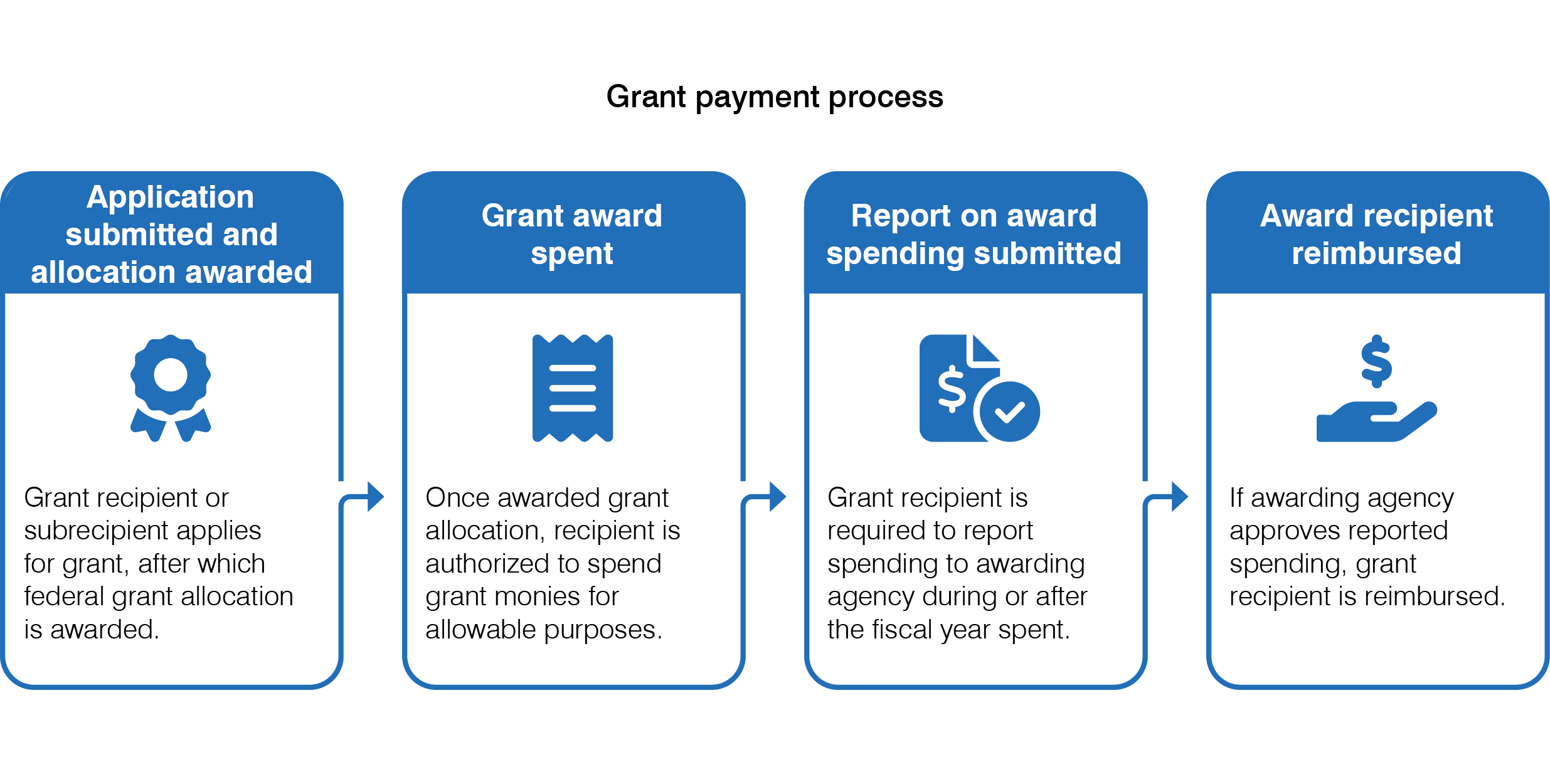
Grantor agencies are responsible for communicating federal allowable spending guidance, approving grant applications, and monitoring districts’ and charters’ spending for allowable use. Specifically, ADE provides guidance and monitoring for ESSER grants, which in total represented the largest portion of the relief monies allocated to districts and charters through June 30, 2022, by reviewing and approving grant application and reimbursement requests, and monitoring district and charter strategies, and outcomes of their ESSER-funded activities. Grantor agencies are also responsible for federally required reporting and reviewing related findings in grant recipients’ audit reports. Under federal and State law, most districts and all charters are required to have independent auditors perform annual financial and compliance audits. Arizona Revised Statutes §15-914 describes districts’ and charters’ audit requirements. Further, districts and charters that expend more than $750,000 in federal monies in a fiscal year are subject to federal single audit. As part of the State of Arizona’s FY 2021 annual single audit, auditors reviewed various programs ADE oversees, including the ESSER grants. See the State of Arizona’s FY 2021 Single Audit Report findings related to ADE’s federal reporting responsibilities.
We compiled 237 districts’ and 445 charters’ reported spending by operational area and type of purchase, and spending and planned future spending by category from their FY 2022 COVID-19 reporting forms we developed and required districts and charters to complete and submit to ADE. The 237 districts included transporting districts, career and technical education districts, and accommodation districts and the 445 charters operated in FYs 2020, 2021, and/or 2022, based on our analysis of ADE-provided school report card information and district and charter report submissions. For the 1 district and 28 charters that closed any time after FY 2020, we reported all available data and did not report results of our followup. For our July 2023 follow-up process, we required all districts and charters that failed to report statutorily required financial information to submit or resubmit their FY 2022 COVID-19 reporting forms. We provided detailed instructions to correct their specific noncompliance and allowed all districts and charters the opportunity to resubmit their reporting form with updated information. During this process, 152 districts and charters resubmitted a FY 2022 COVID-19 reporting form. To ensure accurate and complete financial reporting is available for decision-makers, stakeholders, and the public, we continued to follow up with the 32 districts and 42 charters that were cited for noncompliance and allowed these districts and charters a final opportunity to submit the required information. During this process, all districts and 34 charters corrected their noncompliance. Despite being provided several reminders and instructions for resubmission, 8 charters failed to comply with the statutory COVID-19 federal relief spending reporting submission requirements as of November 2023, as noted by footnote (2) or (15) next to their names in the dashboards and November 2023 final data file. Data from our previously published reports are available in the July 2023 data file and January 2023 data file.
We reported information from the following sources:
District/Charter name — Our analysis of ADE-provided district and charter names used in its school report card website. We added a location to the end of some charter names to distinctly identify charters with otherwise identical names operated under separate charter contracts and also indicated the fiscal year closed, if applicable.
County — Our analysis of ADE-provided county data. For district boundaries encompassing more than 1 county, the county in which the district office resides is presented.
Number of schools — Our analysis of ADE-provided school report card information, including online schools and preschools.
Legislative district(s )— The Arizona Independent Redistricting Commission adopted new legislative district boundaries on January 21, 2022. We used these new boundaries when determining each district’s and charter’s legislative district for this report. For charter schools, we assigned the legislative district where each charter school was located based on ADE-provided addresses. For school districts, we assigned the legislative district(s) based on our analysis of school and legislative district boundaries using 2020 Census Block data from the U.S. Census Bureau.
Student count — ADE-provided, district- and charter-reported FYs 2018 through 2022 unweighted student counts, rounded to the nearest whole number. For the district and charters that have closed since FY 2020 and did not submit FY 2022 reports, we did not report student count information.
State and local revenues from formula funding — ADE-provided student-count-generated formula funding amounts. Districts and charters receive State and local monies from formula funding by weighting certain student types in the student count and multiplying that weighted student count by a base amount. Formula funding changes also include State-wide-approved base amount increases during the years reported and changes in the types of students served.
Fund balance — Our analysis of total fund balance information from district and charter audited financial statements for 215 districts and 417 charters and unaudited AFRs for 17 districts that did not require an audit and 4 accommodation districts included in a county’s audited financial statements. We excluded bond and debt service funds from the districts’ fund balance as those funds have dedicated revenue sources and specified allowable uses. We did not report fund balances for the 1 district and 28 charters that were closed as of June 30, 2022. State-wide fund balance amounts reported in the summary are net of district and charter reported deficit ending fund balances. The State-wide fund balance amounts exclude charters that submit consolidated financial statements with non-Arizona charter schools and entities other than charter schools that operate within the same organization since we were unable to separate and report the individual Arizona charter schools fund balances.
We compared reported grant awards to data obtained from grantor agencies described below:
ESSER I, II, and III — ADE-reported ESSER allocations and awards.
GEER — ADE-reported Acceleration Academies Grant provided from Governor’s Emergency Education Relief (GEER) grants and Arizona Governor’s Office-reported other GEER grants.
CRF/ESG — Arizona Governor’s Office-reported CRF/ESG awards.
Other COVID-19 grants — includes award amounts and spending from the following grantors:
DEMA — Arizona Department of Emergency and Military Affairs (DEMA)-reported Federal Emergency Management Agency Public Assistance Program Grant and Express Pay payments.
National School Lunch Program and Emergency Operational Cost Reimbursement Program — ADE’s Health and Nutrition Services Division-reported district and charter food service program cost reimbursements for March through September 2020, and emergency operational cost reimbursements from relief monies. Districts and charters report these reimbursements within their food service programs and may be reported inconsistently in relief spending detail by category and use.
Paycheck Protection Program (PPP) — Small Business Administration PPP loan forgiveness data as of June 30, 2022.
ARP school and community grants —ADE-reported programs using ADE’s ESSER III set-aside monies.
Education Plus-Up Grant Program — Arizona Governor’s Office-reported program using Coronavirus State and Local Fiscal Recovery Funds established by the ARP Act.
100 Day In-Person Reimbursement — Arizona Governor’s Office-reported program using Coronavirus State and Local Fiscal Recovery Funds established by ARP.
In our FY 2022 COVID-19 reporting form, we required districts and charters to report FY 2022 spending by operational area, type, grant, and category. We also required districts and charters to report total spending through June 30, 2022, with detailed amounts spent for salaries and benefits and other costs in separate tables by category and in total for amounts spent in addition to or instead of available State and local monies for classroom and nonclassroom purposes. Although some districts and charters did not consistently classify spending as salaries and benefits or other spending when reporting amounts in these different tables, total reported spending across the tables was substantially the same. Districts and charters that reported inconsistent information are identified with a footnote as described in the “Report-wide footnotes” section above.
We obtained additional information from districts and charters about their plans for future spending of remaining relief monies in the maintaining operations category through an online survey. The survey asked districts and charters whether they have a written plan for future maintaining operations spending that details the actions they will take before these relief monies are no longer available, including identifying revenue sources that will replace these monies or how the spending will be phased out to ensure the district or charter can operate within its available resources when the federal relief monies are no longer available. We did not require a survey from the 21 districts and 68 charters that were closed as of June 30, 2022, or reported zero planned future relief monies spending for maintaining operations.
To report whether relief monies were used by school districts and charters in addition to or instead of available State and local monies, we provided districts and charters with a FY 2022 COVID-19 reporting form that included detailed instructions for obtaining and reporting to us information related to changes in student count, formula funding, and fund balance from various sources, including the districts’ or charters’ financial statements or the applicable year’s Annual Financial Report (AFR). We further considered if the fund balance change was consistent with the district’s or charter’s reported use of COVID-19 federal relief monies in addition to or instead of available State and local monies as individually described on Dashboard C. However, we excluded 13 districts and 176 charters from our analysis and did not report a determination because:
-
1 district was new for FY 2022.
-
1 district closed in FY 2022.
-
6 districts did not receive relief monies.
-
4 districts contracted for biennial financial statements audits for FYs 2022 and 2023, and therefore we reported the FY 2022 fund balance from the unaudited AFR.
-
1 district was not required to obtain a financial statement audit for all the years presented, and therefore we reported the FYs 2021 and 2022 fund balance from the unaudited AFR.
-
8 charters were new for FY 2022.
-
121 charters submitted audited financial statements as part of a group and did not identify fund balance for individual schools.
-
28 charters closed in FYs 2021 or 2022.
-
6 charters’ financial statements contained activity outside of the charters’ normal operations.
-
13 charters made distributions to shareholders during the years analyzed
We compiled ADE’s use and planned future spending of discretionary relief monies and reported them by category with the goals and descriptions ADE provided.
Our FY 2021 district, charter, and ADE relief spending special report is available on our website at Arizona Auditor General .

